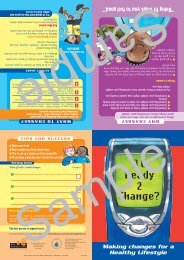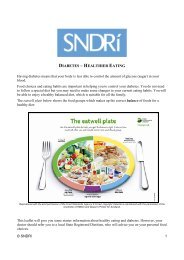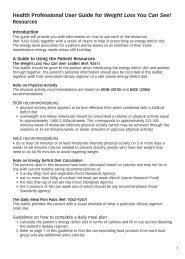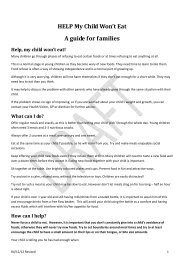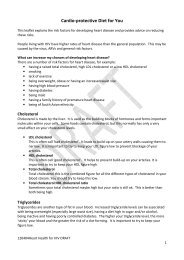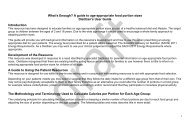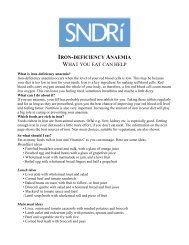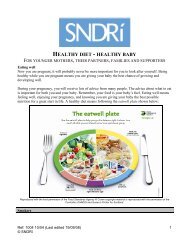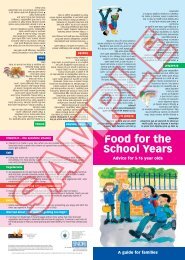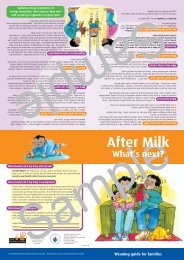9225Introduction to CHOCounting.pdf - NDR-UK
9225Introduction to CHOCounting.pdf - NDR-UK
9225Introduction to CHOCounting.pdf - NDR-UK
Create successful ePaper yourself
Turn your PDF publications into a flip-book with our unique Google optimized e-Paper software.
A practical guide <strong>to</strong><br />
support you through<br />
your diabetes<br />
treatment plan<br />
An Introduction <strong>to</strong><br />
CARBOHYDRATE<br />
COUNTING
AN INTRODUCTION TO<br />
CARBOHYDRATE COUNTING<br />
A practical guide <strong>to</strong> support you through your diabetes treatment plan<br />
C o n t e n t s<br />
• I n t r o d u c t i o n<br />
• Intensive Insulin Therapy and Your Treatment Plan<br />
• B a s a l<br />
• B o l u s<br />
• Do I need <strong>to</strong> count carbohydrate <strong>to</strong> follow my treatment plan?<br />
• Steps <strong>to</strong> your Treatment Plan and Carbohydrate Counting<br />
• What is Carbohydrate?<br />
• Types of carbohydrate<br />
• Do all foods contain carbohydrate?<br />
• Carbohydrate Counting<br />
•Reading labels<br />
- Packaged foods<br />
- Using weights and measures<br />
• Using cooked and uncooked weights<br />
• Using your own recipes<br />
- My favourite recipes<br />
• The carbohydrate calcula<strong>to</strong>r<br />
• Bolus Insulin<br />
• What is my insulin <strong>to</strong> carbohydrate ratio (ICR)?<br />
• How do I work out my ICR?<br />
- My ICR is<br />
- What should I do next?<br />
• How do I use my ICR <strong>to</strong> work out my bolus?<br />
•Bolus calcula<strong>to</strong>r<br />
• Healthy Eating<br />
• Other Things <strong>to</strong> Think A b o u t<br />
• S n a c k s<br />
- What about bedtime snacks?<br />
• Delaying or skipping meals and flexible meal times<br />
• Food choices<br />
p a g e<br />
1<br />
2<br />
2<br />
2<br />
2<br />
3<br />
4<br />
4<br />
5<br />
6<br />
6<br />
6<br />
10<br />
12<br />
16<br />
17<br />
20<br />
22<br />
22<br />
22<br />
22<br />
22<br />
23<br />
24<br />
26<br />
28<br />
28<br />
28<br />
28<br />
28<br />
G e n e ral information B a s a l<br />
Variable fac<strong>to</strong>rs that affect bolus needs Trends and testing<br />
CHO counting Bolus and ICR Adjustments and corrections Trends and ∑<br />
Tre<br />
2 2
I n t r o d u c t i o n<br />
Managing your diabetes can feel like a juggling act.<br />
Start with the basics and <strong>to</strong>gether with your friends and family, you will build skills and<br />
c o n f i d e n c e. This will help you <strong>to</strong> stay in control of your diabetes and enjoy a flexible lifestyle.<br />
Your diabetes team will support you <strong>to</strong> learn and practice the technique that works best for<br />
y o u .<br />
1 00
Intensive Insulin Therapy and Your Treatment Plan<br />
Your treatment plan uses intensive insulin thera p y. This allows you <strong>to</strong> take your insulin in a<br />
way that mimics the normal secretion of insulin from the pancreas. You do this by having one<br />
or two injections of basal (background or long-acting) insulin a day and injections of bolus<br />
( rapid-acting) insulin with foods that contain carbohydra t e.<br />
Using this treatment plan with carbohydrate counting will help you <strong>to</strong> keep your blood glucose<br />
as close <strong>to</strong> normal as possible. You will adjust your insulin <strong>to</strong> b a l a n c e with the carbohydrate in<br />
your meals and snacks, helping you <strong>to</strong> manage everyday life including activity, s p o r t s, s c h o o l ,<br />
stress and illness.<br />
B a s a l<br />
B a s a l means b a c k g r o u n d or l o n g - a c t i n g i n s u l i n . Your body always needs basal insulin <strong>to</strong><br />
keep your blood glucose levels steady and <strong>to</strong> give you energy.<br />
Your basal insulin is<br />
Basal and Bolus Insulin Effect<br />
Insulin Effect<br />
Basal<br />
Bolus<br />
Basal<br />
Bolus<br />
Bolus<br />
Bolus<br />
Time<br />
B o l u s<br />
B o l u s insulin is r a p i d - acting insulin that your body needs when you eat carbohydra t e.<br />
You will take your bolus with meals, and sometimes with snacks. This type of insulin helps<br />
your body deal with the glucose it gets from the carbohydrate in your food.<br />
Your bolus insulin is<br />
Do I need <strong>to</strong> count carbohydrate <strong>to</strong> follow my treatment plan?<br />
C a r b o h y d rate counting will help you <strong>to</strong> get all the benefits from your treatment plan. You will<br />
work out how much carbohydrate is in your meals and snacks then adjust your bolus <strong>to</strong> keep<br />
your blood glucose within your target ra n g e.<br />
It is still important <strong>to</strong> have a healthy diet, but carbohydrate counting gives you more choice of<br />
w h a t , when and how much you can eat. This will help you <strong>to</strong> worry less about eating <strong>to</strong> avoid<br />
h y p o s, or snacking when you are not hungry.<br />
C a r b o h y d rate counting is much more than being able <strong>to</strong> estimate the carbohydrate content of<br />
f o o d s. It is also about learning how <strong>to</strong> adjust your bolus insulin <strong>to</strong> the food you eat and the<br />
activities you enjoy.<br />
Your diabetes team will help and support you <strong>to</strong> count carbohydrate and adjust your insulin.<br />
Your confidence will grow with practice and soon you will realise that you control your<br />
d i a b e t e s !<br />
00 2
R e m e m b e r:<br />
• You always need basal insulin.<br />
• You need bolus insulin each time you eat carbohydra t e.<br />
• C a r b o h y d rate counting will help you get all the benefits from your intensive insulin therapy<br />
treatment plan.<br />
Steps <strong>to</strong> your treatment plan and carbohydrate counting<br />
This pack will guide you through the steps of your treatment plan and carbohydrate counting<br />
<strong>to</strong> help you get all the benefits it can offer. By working with your diabetes team through each<br />
s t a g e, you will grow in confidence by practicing with the examples provided and making notes<br />
<strong>to</strong> remind you of hints and tips <strong>to</strong> help you manage your diabetes.<br />
Step<br />
1. Identify which foods contain<br />
carbohydrate in your meal.<br />
2. Calculate or estimate the<br />
carbohydrate in your meal.<br />
3. Calculate your bolus <strong>to</strong> cover<br />
this carbohydrate.<br />
4. Consider fac<strong>to</strong>rs which may<br />
affect the timing and amount of<br />
bolus you need, such as:<br />
• Your current blood glucose level.<br />
• The amount of activity you<br />
have had.<br />
• The type of food in your meal.<br />
5. Give your bolus, adjusting the<br />
amount and timing as appropriate.<br />
6. Keep records of your blood<br />
glucose, carbohydrate intake<br />
and activities.<br />
7. Look out for trends in your blood<br />
glucose <strong>to</strong> ensure that you are<br />
taking the right amount of basal and<br />
bolus insulin <strong>to</strong> keep optimal control.<br />
Go <strong>to</strong><br />
What is carbohydrate? Introduction <strong>to</strong><br />
Carbohydrate Counting (page 5).<br />
• Reading labels and the carbohydrate calcula<strong>to</strong>r.<br />
Introduction <strong>to</strong> Carbohydrate Counting<br />
(page 7, 21).<br />
• Carbohydrate Tables.<br />
Bolus insulin. Introduction <strong>to</strong> Carbohydrate<br />
Counting (page 25).<br />
Carbohydrate Counting, The Next Steps<br />
(workbook 2).<br />
Carbohydrate Counting, The Next Steps<br />
(workbook 2).<br />
Diary.<br />
Carbohydrate Counting, The Next Steps<br />
(workbook 2) and Diary.<br />
3 00
What is Carbohydrate?<br />
C a r b o h y d rate is a nutrient and source of energy found in foods such as pota<strong>to</strong>es, r i c e, p a s t a ,<br />
c e r e a l s, m i l k , f r u i t , sweets and sugary drinks.<br />
Types of carbohydrate<br />
Different foods contain different types of carbohydra t e.<br />
• Starchy carbohydrate – pota<strong>to</strong>es, r i c e, p a s t a , n o o d l e s, b r e a d , c e r e a l s, c o u s c o u s, l e n t i l s,<br />
beans and products made from flour.<br />
• F r u c t o s e – fruit and fruit juice.<br />
• L a c t o s e – milk, y o g h u r t , ice cream, c u s t a r d .<br />
• S u c r o s e – table sugar, s y r u p, sweets and sugary drinks.<br />
During digestion your body breaks down the carbohydrate from the food you eat in<strong>to</strong> glucose.<br />
This glucose enters your bloodstream and causes your blood glucose <strong>to</strong> rise. Your body needs<br />
insulin <strong>to</strong> use this glucose for energy. The more carbohydrate you eat, the more insulin you will<br />
need <strong>to</strong> keep your blood glucose within your target ra n g e. T h e r e f o r e, knowing how much<br />
c a r b o h y d rate is in the food and drink you take will help you estimate how much insulin you<br />
n e e d .<br />
00 4
For a healthy diet most of your carbohydrate should come from starchy foods, fruit and some<br />
dairy foods. Smaller amounts should be from sugar and sweet foods. Different people need<br />
different amounts of carbohydra t e. The amount of carbohydrate that your body needs<br />
depends on your age, activity levels and weight. In general carbohydrate should make up<br />
about half of your energy (calorie) intake each day.<br />
Do all foods contain carbohydrate?<br />
N o. Some foods contain very little or no carbohydra t e, i n c l u d i n g :<br />
•most vegetables<br />
• m e a t<br />
• f i s h<br />
• e g g s<br />
• c h e e s e<br />
• b u t t e r, margarine and cooking fats and oils.<br />
These foods need little or no insulin but should be included as part of a healthy balanced diet.<br />
You will find more information in Healthy Eating on page 26.<br />
R e m e m b e r:<br />
• Different foods contain different types of carbohydra t e.<br />
• Try <strong>to</strong> have most of your carbohydrate from starchy foods.<br />
• Some foods contain very little or no carbohydra t e.<br />
5 00
Carbohydrate Counting<br />
Reading labels<br />
All packaged food labels have nutritional information for the main nutrients, including energy<br />
( k c a l / k J ) , p r o t e i n , c a r b o h y d rate (CHO) and fat. This is usually given per 100g and sometimes per<br />
p o r t i o n .<br />
The portion figure works well for foods like biscuits, b a r s, yoghurts and ready meals where you<br />
tend <strong>to</strong> eat the suggested portion size. H o w e v e r, if you have a different amount, you will need<br />
<strong>to</strong> calculate the amount of carbohydrate in your portion. This is common for foods like pizza,<br />
p a s t a , breakfast cereal and desserts.<br />
Carbohydrate on food labels<br />
Nutritional labels often show different carbohydrate details. It can be noted in one, t w o<br />
or three parts:<br />
1 . C a r b o hy d rate (always incl u d e d )<br />
2 . of which sugars (often incl u d e d )<br />
3 . of which starch (sometimes incl u d e d ) .<br />
When you are counting carbohydra t e, you must always use the largest c a r b o h y d r a t e<br />
f i g u r e. This is the t o t a l amount of carbohydrate in the food, and includes both the<br />
‘of which sugars’ a n d ‘of which starch ’ a m o u n t s.<br />
Follow the steps below <strong>to</strong> help you work out how much carbohydrate is in your portion, t h e n<br />
p ractice with the examples provided.<br />
Packaged foods<br />
Sometimes the labels show how much carbohydrate is in an example portion, for example:<br />
Wholemeal Bread<br />
Typical values Per slice Per 100g<br />
of product<br />
Energy 102kcal 218kcal<br />
Carbohydrate 19.8g 42.0g<br />
of which sugars 1.3g 2.8g<br />
Fat 1.1g 2.4g<br />
This label shows that one slice of wholemeal bread has 19.8g of carbohydrate in <strong>to</strong>tal.<br />
If you ate 2 slices of bread, you would need <strong>to</strong> multiply the amount of carbohydrate in one<br />
slice of bread by 2.<br />
19.8 x 2 = 39.6g of CHO<br />
00 6
The labels below show suggested portion sizes of different foods. Compare your portion size<br />
<strong>to</strong> those suggested on the labels.<br />
How much carbohydrate is in y o u r p o r t i o n ?<br />
Jaffa Cake s<br />
Typical values Per Jaffa cake Per 100g<br />
Energy 42 kcal 370 kcal<br />
Carbohydrate 7.6g 67.6g<br />
of which sugars 6.0g 53.3g<br />
Fat 1.0 8.8g<br />
If you ate 3 jaffa cakes, you would need <strong>to</strong> multiply the amount of carbohydrate in one jaffa<br />
cake by 3.<br />
7.6 x 3 = 22.8g CHO<br />
Fish Fingers<br />
Typical values Per portion (3 fish fingers) Per 100g<br />
Energy 170 kcal 183 kcal<br />
Carbohydrate 14.0g 15.1g<br />
of which sugars 0.6g 0.7g<br />
Fat 7.1g 7.9g<br />
The label tells you that 3 fish fingers contain 14.0g carbohydrate in <strong>to</strong>tal.<br />
If your portion is a different size, you need <strong>to</strong> change the calculation a little <strong>to</strong> work out how<br />
much carbohydrate you have.<br />
If you want <strong>to</strong> eat a different amount:<br />
1 . Work out how much carbohydrate is in one fish finger.<br />
2 . Multiply this amount by the number of fish fingers you are going <strong>to</strong> have.<br />
1 . Divide the <strong>to</strong>tal amount of CHO in each portion (3 fish fingers) by 3 <strong>to</strong> find the amount in 1<br />
fish finger.<br />
3 fish fingers = 14.0g CHO<br />
14.0 ÷ 3 = 4.6g CHO per fish finger.<br />
2 . Multiply this amount by how many fish fingers you want.<br />
1 fish finger = 4.6g CHO<br />
2 fish fingers = CHO<br />
4 fish fingers = CHO.<br />
7 00
What size is your portion?<br />
Q u i c h e<br />
Foods like pizza, pasta bake or cakes are often shared between people. For example, the label<br />
1<br />
below shows the nutritional values for 100g and for / of a quiche.<br />
Quiche<br />
FRESH AND TASTY<br />
You are going <strong>to</strong> have a 4 of the quiche. You can work out how much is in your portion by<br />
following the steps below.<br />
1 . Work out how much CHO is in the whole quiche.<br />
1<br />
Multiply the CHO in the / quiche portion by 3 <strong>to</strong> work out the CHO in the whole quiche.<br />
15.1 x 3 = 45.3g<br />
2 . Work out how much CHO is in your portion.<br />
1<br />
Divide the CHO in the whole quiche by 4 <strong>to</strong> work out the CHO in /4 .<br />
45.3 ÷ 4 = 11.3g CHO in your portion.<br />
Now try a few on your own <strong>to</strong> practice:<br />
Yo r k s h i re Pudding<br />
1 /<br />
3<br />
3<br />
1/ 3<br />
Typical values Per portion ( quiche) Per 100g<br />
Energy 251kcal 188kcal<br />
Carbohydrate 15.1g 11.3g<br />
of which sugars 3.2g 2.4g<br />
Fat 16.5g 12.4g<br />
You have eaten two Yorkshire puddings. How much carbohydra t e have you had?<br />
Remember only use the higher CHO value for the t o t a l amount of CHO.<br />
00 8
Fruit Biscuits<br />
Fruit<br />
Biscuits<br />
SUITABLE FOR VEGETARIANS<br />
Typical values Per pack (3 biscuits) Per 100g<br />
Energy 165kcal 381kcal<br />
Carbohydrate 32.7g 75.2g<br />
of which sugars 16.2g 37.4g<br />
Fat 2.7g 6.4g<br />
You have 2 biscuits from the pack. How much carbohydrate is in your portion?<br />
P i z z a<br />
Typical values Per<br />
1 /2 pizza Per 100g<br />
Energy 445kcal 281kcal<br />
Carbohydrate 48.9g 30.9g<br />
of which sugars 4.3g 2.7g<br />
Fat 21.1g 12.7g<br />
You ate<br />
1 /3<br />
p i z z a , how much carbohydrate have you had?<br />
9 00
Using weights and measures<br />
For foods like breakfast cereal, cooked rice or pasta it is often easiest <strong>to</strong> weigh your portion<br />
and work out how much carbohydrate it has using the ‘per 100g’ information from the label.<br />
The steps below will help you calculate the carbohydrate in your portion.<br />
1 . Weigh your portion.<br />
2 . Look at the label and check the<br />
amount of carbohydrate per 100g<br />
of product (remember it is the<br />
t o t a l c a r b o h y d rate (CHO) not the<br />
‘of which sugars/starch’.<br />
3 . Divide the amount of carbohydrate in<br />
100g by 100 <strong>to</strong> tell you how much is in 1g.<br />
4 . Multiply this amount by the weight of your<br />
portion <strong>to</strong> tell you how much carbohydrate<br />
is in your p o r t i o n .<br />
This quick equation is:<br />
(CHO per 100g ÷ 100) x weight of your portion<br />
= CHO in your portion.<br />
For example, a bowl of Cheery Cereal:<br />
1 . Weigh your portion.<br />
2 . Look at the label and check the amount of<br />
c a r b o h y d rate in 100g of the product<br />
(remember it is the largest value that shows<br />
the <strong>to</strong>tal carbohydrate not just the ‘ o f<br />
which sugars/starch’).<br />
3 . Work out how much carbohydrate is in 1g.<br />
Divide the amount of CHO in 100g by 100 <strong>to</strong><br />
tell you how much is in 1g.<br />
4 . Work out how much carbohydrate is in your<br />
p o r t i o n .<br />
1 . 40 g<br />
2 . 75g CHO per 100g<br />
3 . 75 ÷ 100 = 0.75g in 1g<br />
4 . 0.75 x 40 = 30g CHO<br />
Multiply the CHO in 1g by the weight of your<br />
portion <strong>to</strong> tell you how much CHO is in your<br />
p o r t i o n .<br />
00 10
If you are calculating the amount of carbohydrate in liquids, use the same equation using<br />
c a r b o h y d rate in a certain volume rather than weight. For example, a milk label shows the<br />
amount of carbohydrate is in 100ml.<br />
SEMI-SKIMMED<br />
THAN<br />
2<br />
LESS<br />
%<br />
FAT<br />
1 . Measure your portion <strong>to</strong> find out how much you’re going <strong>to</strong> have.<br />
1 2 5 m l<br />
2 . Check the label <strong>to</strong> find out how much CHO is in 100ml.<br />
5g CHO per 100ml<br />
3 . Work out how much CHO is in 1ml.<br />
5 ÷ 100 = 0.05ml in 1ml of milk<br />
4 . How much CHO is in your portion?<br />
0.05 x 125 = 6.25g<br />
You have 40g of Instant porridge with 250ml of semi-skimmed milk at breakfast.<br />
How much carbohydrate do you have?<br />
Instant porridge<br />
Typical values<br />
Typical values Per 100ml of Semi-skimmed milk<br />
Energy 48kcal<br />
Protein 3.3g<br />
Carbohydrate 5.0g<br />
of which sugars 5.0g<br />
Fat 1.6g<br />
Per 30g of Instant porridge with<br />
180 ml semi-skimmed milk<br />
Per 100g of<br />
Instant porridge<br />
E n e r g y<br />
C a r b o h y d ra t e<br />
of which sugars<br />
Fa t<br />
280 k c a l<br />
26 . 4 g<br />
9.3 g<br />
4 . 2 g<br />
359 k c a l<br />
58<br />
1 . 0 g<br />
8 . 7 g<br />
Semi-skimmed milk<br />
Typical values<br />
E n e r g y<br />
C a r b o h y d ra t e<br />
of which sugars<br />
Fa t<br />
Per 100ml of Semi-skimmed milk<br />
48kcal<br />
5 . 0 g<br />
5 . 0 g<br />
1 . 6 g<br />
1 . Weigh your portion of Instant porridge.<br />
4 0 g<br />
2 . Check the label <strong>to</strong> see how much CHO is in 100g of porridge.<br />
5 8 g<br />
3 . Work out how much carbohydrate is in 1g of Instant porridge.<br />
58 ÷ 100 = 0.58 CHO/g<br />
11 00
4 . Multiply your portion by the amount of carbohydrate in 1g of Instant porridge.<br />
40 x 0.58 = 23.2g of CHO in your portion<br />
5 . Check the label <strong>to</strong> find out how much CHO is in 100ml of milk.<br />
5g CHO per 100ml<br />
6 . Measure your portion <strong>to</strong> find out how much milk you’re going <strong>to</strong> have.<br />
2 5 0 m l<br />
7 . Work out how much CHO is in 1ml of milk.<br />
5 ÷ 100 = 0.05ml in 1ml of milk<br />
8 . How much CHO is in your portion?<br />
0.05 x 250 = 12.5g CHO in your portion of milk<br />
9 . Add both amounts <strong>to</strong>gether <strong>to</strong> find how much carbohydrate is in your portion of Instant<br />
porridge made with milk.<br />
23.2 + 12.5 = 35.7g CHO al<strong>to</strong>gether<br />
Using uncooked and cooked weights<br />
Some food's weight changes significantly when it is cooked. Foods with starchy<br />
carbohydrates like pasta, rice, pota<strong>to</strong>es n o o d l e s, couscous and pulses all have different<br />
uncooked and cooked weights. This is due <strong>to</strong> the amount of water they absorb or lose<br />
during cooking.<br />
For example:<br />
• Pasta absorbs water when it is cooked.<br />
This means a portion of cooked pasta is<br />
heavier than its dried weight.<br />
• Baking pota<strong>to</strong>es causes them <strong>to</strong> lose water.<br />
This means that a baked pota<strong>to</strong> is lighter<br />
than it was when it was ra w.<br />
When you calculate the carbohydrate in these starchy foods, it is very important that you use<br />
the correct weight and c a r b o h y d rate value in your calculation.<br />
C a r b o h y d rate values for foods can vary by bra n d , cooking method and time. Always try <strong>to</strong><br />
follow cooking instructions and carbohydrate values on foods labels. If this is not possible, u s e<br />
the average values from Carbohydrate Ta b l e s or other reference books.<br />
00 12
Always carefully read labels that provide carbohydrate values for uncooked and cooked<br />
w e i g h t s. Make sure that you understand the label and are using the correct values in your<br />
c a l c u l a t i o n . For example:<br />
Pa s t a 75g dried pasta weighs approximately 170g when cooked<br />
Typical values Each serving 75g when cooked 100g<br />
E n e r g y 260 k c a l 345 k c a l<br />
C a r b o h y d ra t e 54 . 0 g 72 . 0 g<br />
of which sugars 1 . 5 g 2 . 0 g<br />
Fa t 0 . 8 g 1 . 0 g<br />
At the <strong>to</strong>p of the label it states ‘75g of dried pasta weighs approximately 170g when cooke d ’:<br />
• the column ‘ E a ch serving 75g when cooke d ’ refers <strong>to</strong> 170g of c o o k e d p a s t a<br />
• the column ‘100g’ refers <strong>to</strong> uncooked (dried) pasta.<br />
If you weigh your portion of pasta before cooking it, your calculation would follow the standard<br />
method using the details provided in the‘100g’ column.<br />
For example, David has 90g of d r i e d pasta with his dinner. His portion will have:<br />
(72 ÷ 100) x 90 = 64.8g of CHO<br />
H o w e v e r, if you prefer <strong>to</strong> measure your food once it is cooked, you need a few extra steps <strong>to</strong><br />
work out how much carbohydrate is in 1g of c o o k e d p a s t a .<br />
For example, your portion of c o o k e d pasta weighs130g.<br />
1 . Weigh your portion of c o o k e d p a s t a<br />
2 . Look at the label and check the<br />
amount of CHO in the c o o k e d p a s t a .<br />
3 . Divide the amount of CHO in 170g by<br />
170 <strong>to</strong> tell you how much is in 1g.<br />
4 . Multiply this amount by the weight of<br />
your portion <strong>to</strong> tell you how much<br />
CHO is in your portion.<br />
1 . Portion weighs1 3 0 g<br />
2 . Label says:<br />
75g makes approx 170g<br />
c o o k e d.<br />
75g dried provides 54g CHO<br />
t h e re f o re, 170g cooked<br />
p rovides about 54g CHO.<br />
3 . 54 ÷ 170 = 0.32g CHO/1g<br />
cooked pasta<br />
4 . 130 x 0.32 = 42g CHO<br />
13 00
Now think about the rice in the example below.<br />
R i c e 60g uncooked easy cook rice weighs approximately 140g when cooked<br />
Typical values 140g when cooked 100g uncooked<br />
E n e r g y 193 k c a l 383 k c a l<br />
C a r b o h y d ra t e 43 . 3 g 85 . 8 g<br />
of which sugars Tra c e Tra c e<br />
Fa t 1 . 8 g 3 . 6 g<br />
Read the label carefully, then use the space below <strong>to</strong> work out how much carbohydrate is in<br />
your rice if your c o o k e d portion is 80g.<br />
00 14
The handy hints below will help you get started:<br />
• Keep digital scales, a calcula<strong>to</strong>r, a pen and notebook <strong>to</strong> hand in the kitchen.<br />
• Always use the largest c a r b o h y d r a t e figure on nutritional labels. This is the t o t a l amount of<br />
c a r b o h y d rate and includes both the ‘of which sugars’ a n d ‘of which starch’ a m o u n t s.<br />
• When you have weighed food, put it in<strong>to</strong> a cup or bowl so that you know how much food<br />
they hold and you won’t have <strong>to</strong> use the scales every time.<br />
• Don’t confuse uncooked (dry) and cooked weights. Always try <strong>to</strong> follow packet cooking<br />
instructions and use nutritional labels <strong>to</strong> count your carbohydra t e.<br />
• Use a timer <strong>to</strong> cook rice and pasta <strong>to</strong> ensure consistent cooked weights.<br />
• Try <strong>to</strong> become familiar with what foods look like on the plate. This will help you judge how<br />
much carbohydrate is in meals and snacks when you are away from home.<br />
• Foods are often a mixture of protein, fat and carbohydra t e. Remember <strong>to</strong> count carbohydra t e<br />
content in foods such as breadcrumbs on fish, pastry on a meat pie and quiche.<br />
My handy hints<br />
15 00
Using your own recipes<br />
Checking ready meal labels can help you <strong>to</strong> estimate the carbohydrate in homemade versions.<br />
H o w e v e r, it is worth working out the carbohydrate content of your favourite recipes <strong>to</strong> make<br />
sure you have accurate values.<br />
To work out carbohydrate in homemade foods:<br />
1 . Write down all the ingredients. N o t e :<br />
a . the amount of carbohydrate each ingredient has per 100g (CHO/100g)<br />
b. the weight of each used ingredient in the recipe (g).<br />
2 . Work out how much carbohydrate is in each ingredient using the method described in<br />
Using weights and measures (page 10).<br />
(CHO per 100g ÷ 100) x weight = CHO<br />
3 . Add all the ingredients’ carbohydrate values <strong>to</strong>gether. This is the <strong>to</strong>tal amount of<br />
c a r b o h y d rate in the whole recipe.<br />
4 . Divide this <strong>to</strong>tal by the number of portions <strong>to</strong> give the amount of carbohydrate per portion.<br />
The examples below show you how <strong>to</strong> work out the carbohydrate for two recipes.<br />
Sultana Scones – Makes 8 scones<br />
I n g r e d i e n t C H O / 100 g Weight (g) C a l c u l a t i o n C H O / i n g r e d i e n t<br />
F l o u r 78 200 (78 ÷ 100) x 200 156<br />
M a r g a r i n e - 50 - -<br />
S u g a r 100 50 (100 ÷ 100) x 50 50<br />
M i l k 5 125 (5 ÷ 100) x 125 6 . 25<br />
E g g - 1 egg - -<br />
S u l t a n a s 69 50 (69 ÷ 100) x 50 34 . 5<br />
Whole re c i p e 230 . 75<br />
Total CHO/scone 246.75 ÷ 8 = 30.87g<br />
Macaroni Cheese – Serves 2<br />
I n g r e d i e n t C H O / 100 g Weight (g) C a l c u l a t i o n C H O / i n g r e d i e n t<br />
M a c a ro n i 75 75 (75 ÷ 100) x 75 56 . 25<br />
(uncooked weight)<br />
C h e e s e - 150 g - -<br />
F l o u r 78 40 (78 ÷ 100) x 40 31 . 2<br />
M a r g a r i n e - 40 - -<br />
M i l k 5 375 (5 ÷ 100) x 375 18 . 75<br />
Whole re c i p e 106 . 2<br />
Total CHO/serving 106.2 ÷ 2 = 53.1<br />
00 16
My favourite recipes<br />
Use the space below <strong>to</strong> make work out how much carbohydrate is in some of your favourite<br />
r e c i p e s. You can add the values <strong>to</strong> your Carbohydrate Ta b l e s as a quick reminder.<br />
17 00
Using carbohydrate reference tables and the carbohydrate calcula<strong>to</strong>r<br />
When you are out and about, it may not be possible <strong>to</strong> weigh your foods and calculate how<br />
much carbohydrate your food has. There are lots of books and resources available <strong>to</strong> help you<br />
work out the carbohydrate in foods. The Carbohydrate Ta b l e s pocket guide in this pack will<br />
help you count carbohydrate when you are out and about.<br />
Using the method and examples shown earlier with your Carbohydrate Ta b l e s <strong>to</strong> work out<br />
how much carbohydrate is in:<br />
• 2 slices of wholemeal <strong>to</strong>ast with jam<br />
• your usual cereal and milk with a medium banana<br />
• one of your favourite foods or drinks.<br />
What happens if you change the portion size?<br />
00 18
Think of more meals and snacks that you like. Use the space below <strong>to</strong> work out how much<br />
c a r b o h y d rate is in your normal portion.<br />
19 00
The carbohydrate calcula<strong>to</strong>r<br />
This chart will help you calculate how much carbohydrate is in a specific portion size of foods<br />
using packet labels.<br />
• Look on the label for how much carbohydrate is in 100g – remember <strong>to</strong> use the TOTAL<br />
C A R B O H Y D R AT E, not the ‘of which sugars/starch’ figure.<br />
• Weigh your portion so you know how much you are going <strong>to</strong> have.<br />
• Read along the bot<strong>to</strong>m (purple) <strong>to</strong> the amount of carbohydrate/100g, then up the side (black)<br />
(black) <strong>to</strong> the weight of your portion.<br />
• Where the lines meet is the amount <strong>to</strong> carbohydrate in your portion.<br />
Carbohydrate calcula<strong>to</strong>r<br />
Weight of food (g)<br />
20 0<br />
17 5<br />
15 0<br />
14 0<br />
13 0<br />
12 0<br />
11 0<br />
10 0<br />
95<br />
90<br />
85<br />
80<br />
75<br />
70<br />
65<br />
60<br />
55<br />
50<br />
45<br />
40<br />
35<br />
30<br />
25<br />
20<br />
15<br />
10<br />
5<br />
0<br />
10 20 30 40 50 60 70 80 90 10 0 11 0 12 0 13 0 14 0 15 0 16 0 17 0 18 0 19 0 20 0<br />
9 17 26 35 44 52 61 70 79 87 96 10 5 11 4 12 2 13 1 14 0 14 9 15 7 16 6 17 5<br />
7 15 22 30 37 45 52 60 67 75 82 90 97 10 5 11 2 12 0 12 7 13 5 14 2 15 0<br />
7 14 21 28 35 42 49 56 63 70 77 84 91 98 10 5 11 2 11 9 12 6 13 3 14 0<br />
6 13 19 26 32 39 45 52 58 65 71 78 84 91 97 10 4 11 0 11 7 12 3 13 0<br />
6 12 18 24 30 36 42 48 54 60 66 72 78 84 90 96 10 2 10 8 11 4 12 0<br />
5 11 16 22 27 33 38 44 49 55 60 66 71 77 82 88 93 99 104 110<br />
5 10 15 20 25 30 35 40 45 50 55 60 65 70 75 80 85 90 95 100<br />
5 10 14 19 24 29 33 38 43 48 52 57 62 67 71 76 81 86 90 95<br />
5 9 14 18 23 27 32 36 41 45 50 54 59 63 68 72 77 81 86 90<br />
4 9 13 17 21 26 30 34 38 43 47 51 55 60 64 68 72 77 81 85<br />
4 8 12 16 20 24 28 32 36 40 44 48 52 56 60 64 68 72 76 80<br />
4 8 11 15 19 23 26 30 34 38 41 45 49 53 56 60 64 68 71 75<br />
4 7 11 14 18 21 25 28 32 35 39 42 46 49 53 56 60 63 67 70<br />
3 7 10 13 16 20 23 26 29 33 36 39 42 46 49 52 55 59 62 65<br />
3 6 9 12 15 18 21 24 27 30 33 36 39 42 45 48 51 54 57 60<br />
3 6 8 11 14 17 19 22 25 28 30 33 36 39 41 44 47 50 52 55<br />
3 5 8 10 13 15 18 20 23 25 28 30 33 35 38 40 43 45 48 50<br />
2 5 7 9 11 14 16 18 20 23 25 27 29 32 34 36 38 41 43 45<br />
2 4 6 8 10 12 14 16 18 20 22 45 26 28 30 32 34 36 38 40<br />
2 4 5 7 9 11 12 14 16 18 19 21 23 25 26 28 30 32 33 35<br />
2 3 5 6 8 9 11 12 14 15 17 18 20 21 23 24 26 27 29 30<br />
1 3 4 5 6 8 9 10 11 13 14 15 16 18 19 20 21 23 24 25<br />
1 2 3 4 5 6 7 8 9 10 11 12 13 14 15 16 17 18 19 20<br />
1 2 2 3 4 5 5 6 7 8 8 9 10 11 11 12 13 14 14 15<br />
1 1 2 2 3 3 4 4 5 5 6 6 7 7 8 8 9 9 10 10<br />
* 1 1 1 1 2 2 2 2 3 3 3 3 4 4 4 4 5 5 5<br />
5 10 15 20 25 30 35 40 45 50 55 60 65 70 75 80 85 90 95 100<br />
* Negligible<br />
Carbohydrate/100g (shown on label)<br />
00 20
For example<br />
• You have a bowl of bran flakes that weighs 45g.<br />
• B ran flakes have 65g CHO per 100g.<br />
• Read along the bot<strong>to</strong>m (purple) line <strong>to</strong> 65 and up the side (black) <strong>to</strong> 45.<br />
• Where the lines meet is the amount <strong>to</strong> CHO in your portion (29g).<br />
Weight of food (g)<br />
2 0 0<br />
10 20 30 40 50 60 70 80 90 10 0 11 0 12 0 13 0 14 0 15 0 16 0 17 0 18 0 19 0 20 0<br />
1 7 5<br />
9 17 26 35 44 52 61 70 79 87 96 10 5 11 4 12 2 13 1 14 0 14 9 15 7 16 6 17 5<br />
1 5 0<br />
7 15 22 30 37 45 52 60 67 75 82 90 97 10 5 11 2 12 0 12 7 13 5 14 2 15 0<br />
1 4 0<br />
7 14 21 28 35 42 49 56 63 70 77 84 91 98 10 5 11 2 11 9 12 6 13 3 14 0<br />
1 3 0<br />
6 13 19 26 32 39 45 52 58 65 71 78 84 91 97 10 4 11 0 11 7 12 3 13 0<br />
1 2 0<br />
6 12 18 24 30 36 42 48 54 60 66 72 78 84 90 96 10 2 10 8 11 4 12 0<br />
1 1 0<br />
5 11 16 22 27 33 38 44 49 55 60 66 71 77 82 88 93 99 104 110<br />
1 0 0<br />
5 10 15 20 25 30 35 40 45 50 55 60 65 70 75 80 85 90 95 100<br />
9 5 5 10 14 19 24 29 33 38 43 48 52 57 62 67 71 76 81 86 90 95<br />
9 0 5 9 14 18 23 27 32 36 41 45 50 54 59 63 68 72 77 81 86 90<br />
8 5 4 9 13 17 21 26 30 34 38 43 47 51 55 60 64 68 72 77 81 85<br />
8 0 4 8 12 16 20 24 28 32 36 40 44 48 52 56 60 64 68 72 76 80<br />
7 5 4 8 11 15 19 23 26 30 34 38 41 45 49 53 56 60 64 68 71 75<br />
7 0 4 7 11 14 18 21 25 28 32 35 39 42 46 49 53 56 60 63 67 70<br />
6 5 3 7 10 13 16 20 23 26 29 33 36 39 42 46 49 52 55 59 62 65<br />
6 0 3 6 9 12 15 18 21 24 27 30 33 36 39 42 45 48 51 54 57 60<br />
5 5 3 6 8 11 14 17 19 22 25 28 30 33 36 39 41 44 47 50 52 55<br />
5 0 3 5 8 10 13 15 18 20 23 25 28 30 33 35 38 40 43 45 48 50<br />
4 5 2 5 7 9 11 14 16 18 20 23 25 27 29 32 34 36 38 41 43 45<br />
4 0 2 4 6 8 10 12 14 16 18 20 22 45 26 28 30 32 34 36 38 40<br />
3 5 2 4 5 7 9 11 12 14 16 18 19 21 23 25 26 28 30 32 33 35<br />
3 0 2 3 5 6 8 9 11 12 14 15 17 18 20 21 23 24 26 27 29 30<br />
2 5 1 3 4 5 6 8 9 10 11 13 14 15 16 18 19 20 21 23 24 25<br />
2 0 1 2 3 4 5 6 7 8 9 10 11 12 13 14 15 16 17 18 19 20<br />
1 5 1 2 2 3 4 5 5 6 7 8 8 9 10 11 11 12 13 14 14 15<br />
1 0 1 1 2 2 3 3 4 4 5 5 6 6 7 7 8 8 9 9 10 10<br />
5 * 1 1 1 1 2 2 2 2 3 3 3 3 4 4 4 4 5 5 5<br />
0 5 10 15 20 25 30 35 40 45 50 55 60 65 70 75 80 85 90 95 100<br />
* Negligible<br />
Carbohydrate/100g (shown on label)<br />
21 00
Bolus Insulin<br />
When you start on your treatment plan, your diabetes team will advise you what bolus you<br />
n e e d .<br />
There are some important things* you need <strong>to</strong> know when working out how much bolus<br />
insulin you need. For example:<br />
• the carbohydrate content of your meal<br />
• your insulin <strong>to</strong> carbohydrate ratio (ICR)<br />
• your current blood glucose level.<br />
*Other fac<strong>to</strong>rs such as activity are considered in greater detail in Carbohydrate Counting, The Next Steps (workbook 2).<br />
What is my insulin <strong>to</strong> carbohydrate ratio (ICR)?<br />
Your ICR is the number of grams of carbohydrate covered by a certain amount of bolus insulin.<br />
This ratio varies between people. It is affected by how long you have had diabetes, y o u r<br />
w e i g h t , a g e, how much exercise you take or if you are ill. Some people have different ICRs for<br />
different meals or meal times throughout the day.<br />
How do I work out my ICR?<br />
Your diabetes team will help you <strong>to</strong> work out and check your ICR*.<br />
My ICR is<br />
* Variable ICRs are considered in greater detail in<br />
Carbohydrate Counting, The Next Steps (workbook 2).<br />
What should I do next?<br />
Now that you know your ICR and have learned how <strong>to</strong> accurately count the amount of<br />
c a r b o h y d rate in your meals and snacks, you can calculate how much insulin you need at each<br />
b o l u s.<br />
Your diabetes team will work through examples with you until you are confident working out<br />
your bolus by yourself.<br />
00 22
How do I use my ICR <strong>to</strong> work out my bolus?<br />
1 . Work out how much carbohydrate is in your meal or snack.<br />
2 . Divide the weight of carbohydrate in your meal or snack by the weight of carbohydrate in your<br />
ICR and multiply this by the units of insulin in your ICR.<br />
If your meal has 40g of carbohydrate and your ICR is 1:10, you should have 4 units of bolus<br />
insulin.<br />
(40 ÷ 10) x 1= 4 units of insulin<br />
If your meal has 60g of carbohydrate and your ICR is 1:7.5 (or 2:15), you should have 8 units of<br />
bolus insulin.<br />
(60 ÷ 7.5) x 1 = 8 units of insulin<br />
((60 ÷ 15) x 2 = 8 units of insulin)<br />
Look at the example below.<br />
M e a l C a r b o h y d r a t e I C R C a l c u l a t i o n B o l u s<br />
B r e a k f a s t 5 0 g 1 : 1 0 (50 ÷ 10) x 1 = 5 5<br />
L u n c h 6 0 g 1 : 1 5 (60 ÷ 15) x 1 = 4 4<br />
D i n n e r 9 0 g 1 : 1 5 (90 ÷ 15) x 1 = 6 6<br />
Now try and work it out for some of your own meals in the table below:<br />
M e a l C a r b o h y d r a t e I C R C a l c u l a t i o n B o l u s<br />
B r e a k f a s t<br />
L u n c h<br />
D i n n e r<br />
23 00
Bolus calcula<strong>to</strong>r<br />
The chart below is a helpful <strong>to</strong>ol <strong>to</strong> quickly work out what your bolus should be when you<br />
know how much carbohydrate you are going <strong>to</strong> have.<br />
• Work out how much carbohydrate you are going <strong>to</strong> have.<br />
• Read along the bot<strong>to</strong>m (purple) <strong>to</strong> your ICR then up the side (pink) <strong>to</strong> the amount of<br />
carbohydrate you are going <strong>to</strong> have.<br />
• Where the lines meet is the amount of insulin you should have in your bolus*.<br />
Bolus calcula<strong>to</strong>r<br />
Carbohydrate in food (g)<br />
100<br />
95<br />
90<br />
85<br />
80<br />
75<br />
70<br />
65<br />
60<br />
55<br />
50<br />
45<br />
40<br />
35<br />
30<br />
25<br />
20<br />
15<br />
10<br />
0<br />
20 12.5 10 8.5 6.5 5 4 3.5<br />
19 12 9.5 8 6.5 4.5 4 3<br />
18 11 9 7.5 6 4.5 3.5 3<br />
17 10.5 8.5 7 5.5 4 3.5 3<br />
16 10 8 6.5 5.5 4 3 2.5<br />
15 9 7.5 6 5 3.5 3 2.5<br />
14 8.5 7 6 4.5 3.5 3 2.5<br />
13 8 6.5 5.5 4.5 3 2.5 2<br />
12 7.5 6 5 4 3 2.5 2<br />
11 7 5.5 4.5 3.5 2.5 2 2<br />
10 6 5 4 3.5 2.5 2 1.5<br />
9 5.5 4.5 4 3 2 2 1.5<br />
8 5 4 3.5 2.5 2 1.5 1.5<br />
7 4.5 3.5 3 2.5 1.5 1.5 1<br />
6 3.5 3 2.5 2 1.5 1 1<br />
5 3 2.5 2 1.5 1 1 1<br />
4 2.5 2 1.5 1.5 1 1 0.5<br />
3 2 1.5 1 1 0.5 0.5 0.5<br />
12 1 1 1 0.5 0.5 0.5 0.5<br />
1:5 1:8 1:10 1:12 1:15 1:20 1:25 1:30<br />
Insulin <strong>to</strong> carbohydrate ratio (ICR)<br />
(units of insulin:grams carbohydra t e )<br />
*Bolus units are rounded <strong>to</strong> the nearest 0.5 units.<br />
00 24
For example<br />
• You are going <strong>to</strong> have a bowl of bran flakes. You have calculated that this has 30g of CHO.<br />
• Your ICR is 1:10.<br />
• Read along the bot<strong>to</strong>m (purple) <strong>to</strong> 1:10 and up the side (pink) <strong>to</strong> 30.<br />
• Where the lines meet is the amount of bolus insulin you should have – 3 units*.<br />
Carbohydrate in food (g)<br />
100<br />
95<br />
90<br />
85<br />
80<br />
75<br />
70<br />
65<br />
60<br />
55<br />
50<br />
45<br />
40<br />
35<br />
30<br />
25<br />
20<br />
15<br />
10<br />
0<br />
20 12.5 10 8.5 6.5 5 4 3.5<br />
19 12 9.5 8 6.5 4.5 4 3<br />
18 11 9 7.5 6 4.5 3.5 3<br />
17 10.5 8.5 7 5.5 4 3.5 3<br />
16 10 8 6.5 5.5 4 3 2.5<br />
15 9 7.5 6 5 3.5 3 2.5<br />
14 8.5 7 6 4.5 3.5 3 2.5<br />
13 8 6.5 5.5 4.5 3 2.5 2<br />
12 7.5 6 5 4 3 2.5 2<br />
11 7 5.5 4.5 3.5 2.5 2 2<br />
10 6 5 4 3.5 2.5 2 1.5<br />
9 5.5 4.5 4 3 2 2 1.5<br />
8 5 4 3.5 2.5 2 1.5 1.5<br />
7 4.5 3.5 3 2.5 1.5 1.5 1<br />
6 3.5 3 2.5 2 1.5 1 1<br />
5 3 2.5 2 1.5 1 1 1<br />
4 2.5 2 1.5 1.5 1 1 0.5<br />
3 2 1.5 1 1 0.5 0.5 0.5<br />
12 1 1 1 0.5 0.5 0.5 0.5<br />
1:5 1:8 1:10 1:12 1:15 1:20 1:25 1:30<br />
Insulin <strong>to</strong> carbohydrate ratio (ICR)<br />
(units of insulin:grams carbohydra t e )<br />
*Bolus units are rounded <strong>to</strong> the nearest 0.5 units.<br />
R e m e m b e r:<br />
• Your ICR is your insulin <strong>to</strong> carbohydrate ra t i o.<br />
• Use your ICR <strong>to</strong> calculate how much bolus you need with your meals and snacks.<br />
• The bolus calcula<strong>to</strong>r can help you <strong>to</strong> quickly check what bolus you need.<br />
25 00
Healthy Eating<br />
The diet for people with diabetes is not a special diet – it should be a healthy diet that all your<br />
family and friends can enjoy. Using your treatment plan with carbohydrate counting enables<br />
you <strong>to</strong> balance your carbohydrate intake with your insulin. It gives you greater choice of what,<br />
when and how much you eat. You will have more flexibility with this plan, but it is still<br />
important <strong>to</strong> follow healthy eating guidelines. These help you <strong>to</strong> grow, keep well and avoid<br />
gaining <strong>to</strong>o much weight.<br />
The eatwell plate below shows you the types and proportions of the different foods you need<br />
<strong>to</strong> have a well balanced and healthy diet.<br />
eatwell plate<br />
Reproduced with the kind permission of the Food Standards Agency © Crown copyright<br />
material is reproduced with the permission of the Controller of HMSO and<br />
Queen's Printer for Scotland<br />
Try <strong>to</strong> eat regularly and choose a variety of foods from the green, y e l l o w, pink and blue groups<br />
every day <strong>to</strong> provide your body with the nutrients it needs. Foods in the purple group – food<br />
and drinks high in fat and/or sugar – are not essential and should form the smallest part of<br />
your diet.<br />
B r e a d s, r i c e, p o t a t o e s, pasta and other starchy foods<br />
• Make these foods the main part of every meal.<br />
• Choose wholemeal, w h o l e g ra i n , brown or high-fibre versions where possible.<br />
Milk and dairy foods<br />
• Try <strong>to</strong> include these foods every day.<br />
• Choose lower-fat alternatives where possible.<br />
M e a t , f i s h , e g g s, b e a n s<br />
• Aim <strong>to</strong> eat small portions of these foods at meals.<br />
• Try <strong>to</strong> eat more fish and aim for one <strong>to</strong> two portions of oily fish such as salmon, herring or<br />
pilchards each week.<br />
00 26
Fruit and vegetables<br />
• Aim <strong>to</strong> have a minimum of 5 portions of fruit and vegetables every day.<br />
• Try <strong>to</strong> choose from a wide variety of fruit and vegetables.<br />
Fatty foods<br />
• These foods include butter, margarine and cooking oils and many snack and convenience<br />
foods such as mayonnaise, salad dressings, c r i s p s, n u t s, savoury and sweet pastries, ice<br />
cream and chocolate.<br />
• These foods should be used sparingly as eating <strong>to</strong>o much can lead <strong>to</strong> being overweight.<br />
• Try <strong>to</strong> choose spreads and cooking oils which are higher in monosaturated or<br />
p o l y u n s a t u rated oil, for example olive oil or sunflower oil. Aim <strong>to</strong> use small amounts of these<br />
as the calorie content is the same as butter or lard.<br />
• G r i l l i n g , b a k i n g , boiling and stir frying are healthier methods of cooking.<br />
• Low-fat or reduced-fat alternatives can be a healthier alternative, but ensure that you read<br />
food labels <strong>to</strong> check the nutritional information.<br />
Sugar and sweet foods<br />
• These do not have <strong>to</strong> be avoided but eating <strong>to</strong>o much of these can lead <strong>to</strong> <strong>to</strong>oth decay and<br />
being overweight.<br />
S a l t<br />
• Salt intake should be kept <strong>to</strong> a minimum as <strong>to</strong>o much can lead <strong>to</strong> health problems such as<br />
high blood pressure. Processed foods such as crisps, pastries, ready meals and soups all<br />
contain salt so try not <strong>to</strong> have these <strong>to</strong>o often.<br />
• If you have used a little salt in cooking try <strong>to</strong> avoid adding any more at the table.<br />
R e m e m b e r:<br />
• Base your meals on starchy foods.<br />
• Try <strong>to</strong> have at least 5 portions of fruit and vegetables a day.<br />
• Eat more fish.<br />
• Cut down on fatty and sugary foods.<br />
• Try <strong>to</strong> limit salt.<br />
27 00
Other Things <strong>to</strong> Think A b o u t<br />
As you become more confident with your treatment plan, you can think more about your food<br />
c h o i c e s, m e a l t i m e s, activities and lifestyle <strong>to</strong> give you even more flexibility. Keeping a diary of<br />
these points will help you <strong>to</strong> spot trends and have better control.<br />
S n a c k s<br />
You do not need regular snacks on your treatment plan.<br />
• If you want a snack, think about when your last bolus was and how much carbohydrate is in<br />
your snack.<br />
• If your snack contains more than g of carbohydrate or is after hours of<br />
your last bolus, you will need <strong>to</strong> take a bolus of insulin.<br />
The best way <strong>to</strong> check if this works is<br />
<strong>to</strong> regularly check your blood glucose.<br />
You generally won’t need <strong>to</strong> bolus if you take carbohydrate <strong>to</strong> treat a hypo or for extra energy<br />
during activity. Discuss this with your diabetes team.<br />
What about bedtime snacks?<br />
It can be tempting <strong>to</strong> avoid a bolus with your bedtime snack if you are worried about hypos<br />
during the night. H o w e v e r, your blood glucose may be high for several hours and only come<br />
down with your basal insulin. Discuss this with your diabetes team.<br />
R e m e m b e r, you don’t really know what your blood glucose is during the night unless you test it<br />
from time-<strong>to</strong>-time.<br />
Delaying or skipping meals and flexible meal times<br />
It is important <strong>to</strong> try and have three regular meals a day. G e n e ra l l y, your treatment plan means<br />
that you won’t need <strong>to</strong> stick <strong>to</strong> set mealtimes. This is most likely <strong>to</strong> happen on special<br />
o c c a s i o n s, if you are away from home or not at school.<br />
If you delay or even skip a meal you:<br />
• should follow your standard ICR when you do have your meal<br />
• may need <strong>to</strong> have an extra bolus if you want <strong>to</strong> have an extra snack<br />
• still need <strong>to</strong> take your basal insulin at the same time regardless of when you are going<br />
<strong>to</strong> eat.<br />
Food choices<br />
Not all carbohydrate foods are digested at the same ra t e. Some are digested quicker and will<br />
raise your blood glucose level faster than others. This is covered in detail in C a r b o h y d r a t e<br />
Counting, The Next Steps (workbook 2), where you will also consider the timing of your<br />
b o l u s.<br />
00 28
This information has been produced for S<strong>NDR</strong>í by Registered Dietitians and other relevant health professionals. At the time of publication the information contained<br />
within the leaflet was, <strong>to</strong> the best of our knowledge, correct and up-<strong>to</strong>-date. Always consult a suitably qualified dietitian and/or your GP on health problems.<br />
S<strong>NDR</strong>í cannot be held responsible for how clients/patients interpret and use the information within this resource.<br />
© S<strong>NDR</strong>í, First Published 12/10, Ref 9225<br />
Reviewed XX/XX, XX/XX<br />
Visit www.gcu.ac.uk/sndri for ordering information and enquiries<br />
Hosted by Glasgow Caledonian University and part funded by the<br />
Scottish Government and Welsh Assembly Government.<br />
A Registered Dietitians’ project, in partnership with other agencies.




